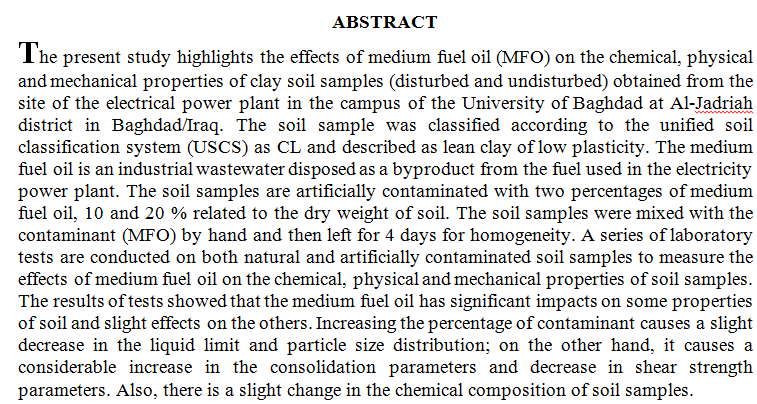
 (4)
(4)
 (5)
(5)
This study aimed to extraction of essential oil from peppermint leaves by using hydro distillation methods. In the peppermint oil extraction with hydro distillation method is studied the effect of the extraction temperature to the yield of peppermint oil. Besides it also studied the kinetics during the extraction process. Then, 2nd -order mechanism was adopted in the model of hydro distillation for estimation many parameters such as the initial extraction rate, capacity of extraction and the constant rat of extraction with various temperature. The same model was also used to estimate the activation energy. The results showed a spontaneous process, since the Gibbs free energy had a value negative sign.
 (7)
(7)
This study focuses on the use of an optimum amount of Sodium Polyacrylate (SP) for designing cement slurry with the high performance of rheological properties and displacement efficiency. A laboratory study has been carried out on the cement slurry which prepared with SP as superabsorbent polymer. SP has been providing an internal water source that helps in the hydration process, and curing and ultimately increases the cement strength. Also improves the cement performance by improving the cement stability. Several batches were prepared to determine the proper amount of SP to add it in the cement slurry. Also, we studied its effect on cement density, amount of free water in order to observe the rheological properties, and thickening time.
... Show MoreThe Nuclear structure of 110-116Cd isotopes was studied theoretically in the framework of the interacting boson model of IBM-l and IBM-2. The properties of the lowest mixed symmetry states such as the 1+, 2+ and 3+ levels produced by the IBM-2 model in the vibrational-limit U(5) of Cd - isotopes are studied in details. This analysis shows that the character of mixed symmetry of 2+ is shared between and states in 110-114Cd – isotopes, the large shar goes to s, while in isotope, the state is declared as a mixed symmetry state without sharing. This identification is confirmed by the percentage of F-spin contribution. The electromagnetic properties of E2 and Ml operators were investigated and the results were analyzed. Various
... Show MoreAn optimization calculation is made to find the optimum properties of combined quadrupole lens which consists of electrostatic and magnetic lens. Both chromatic and spherical aberration coefficients are reduced to minimum values and the achromatic aberration is found for many cases. These calculations are achieved with the aid of transfer matrices method and using rectangular model of field distribution, where the path of charged-particles beam traversing the field has been determined by solving the trajectory equation of motion and then the optical properties for lens have been computed with the aid of the beam trajectory along the lens axis. The computations have been concentrated on determining the chromatic and spher
... Show MoreExposure to cryogenic liquids can significantly impact the petrophysical properties of rock, affecting its density, porosity, permeability, and elastic properties. These effects can have important implications for various applications, including oil and gas production and carbon sequestration. Cryogenic liquid fracturing is a promising alternative to traditional hydraulic fracturing for exploiting unconventional oil and gas resources and geothermal energy. This technology offers several advantages over traditional hydraulic fracturing, including reduced water consumption, reduced formation damage, and a reduced risk of flow-back fluid contamination. In this study, an updated review of recent studies demonstrates how the
... Show More (2)
(2)
Background: Mineral Trioxide Aggregate (MTA) and BiodentineTM cements are new materials with numerous exciting clinical applications. Both have appreciable properties which include good physical properties and the ability to stimulate tissue regeneration as well as good antibacterial effects. The aim of this study was to investigate and compare the antibacterial effects of MTA and BiodentineTM, when they were mixed with different concentrations of aqueous solutions of Black Seed extract, against Enterococcus faecalis. Materials and methods: MTA and BiodentineTMwere prepared according to the manufacturer’s instructions. The method of Mawlood was followed to prepare the Black Seed aqueous solution. Agar diffusion method on Brain Heart
... Show More(1) Background: Plant flavonoids are efficient in preventing and treating various diseases. This study aimed to evaluate the ability of hesperidin, a flavonoid found in citrus fruits, in inhibiting lipopolysaccharide (LPS) induced inflammation, which induced lethal toxicity in vivo, and to evaluate its importance as an antitumor agent in breast cancer. The in vivo experiments revealed the protective effects of hesperidin against the negative LPS effects on the liver and spleen of male mice. (2) Methods: In the liver, the antioxidant activity was measured by estimating the concentration of glutathione (GSH) and catalase (CAT), whereas in spleen, the concentration of cytokines including IL-33 and TNF-α was measured. The in vitro expe
... Show More (40)
(40)
 (34)
(34)
This study involves the synthesis of a new class of silicon polymers, designated as P1-P7, derived from dichlorodimethylsilane (DCDMS) in combination with various organic compounds (Schiff bases prepared from different amines and appropriate aldehydes or ketones) [I-V] through condensation polymerization. The structures of all monomers and polymers were characterization by FTIR and 1HNMR spectroscopy (for some polymers). The results of thermogravimetric analysis (TGA) and differential scanning calorimetry DSC test show stable thermal behaviour. Polymers with a higher concentration of aromatic rings in their repeating structural units exhibited a higher temperature for weight loss, indicating increased thermal stability. Thermal meas
... Show More